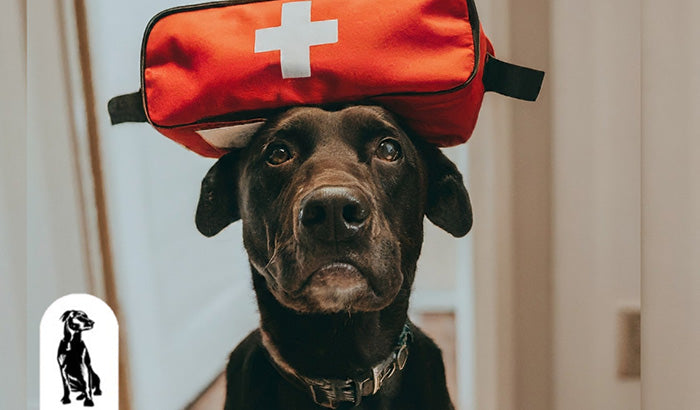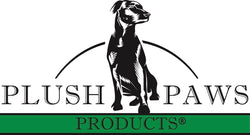
Mastering basic first aid for dogs will significantly aid in managing minor injuries at home or stabilizing your pet in severe emergencies until professional help is reached.
This blog will cover essential pet first aid techniques, from assembling a comprehensive first aid kit to handling various emergencies like cuts, poisoning, allergic reactions, CPR needs, thermal stress, and choking situations. With the right knowledge and skills, you’ll be equipped to provide the best care for your dog in any situation.
Let's begin this crucial educational journey for every responsible pet owner.
Basic first aid kit for dogs
Having a well-prepared first aid kit is crucial for effectively handling minor injuries or stabilizing your dog until professional help is available.
Your kit should include essentials like:
- adhesive and non-adhesive bandages for different types of wounds.
- antiseptic wipes and sprays for cleaning and preventing infection.
- a digital thermometer for accurate temperature readings.
- tweezers and scissors for removing splinters or cutting fur.
- saline solution for flushing out debris.
- gauze.
- an ice pack for swelling.
- emergency contact information for your vet.
Store the first aid kit in a cool, dry place away from direct sunlight to prevent degradation of supplies and ensure it remains sterile and ready to use. Regularly check and update the kit every three months, replacing any used or expired items. Keep it in an accessible location and ensure it is in a waterproof container if you’re often outdoors or in damp environments.
Being prepared with these essentials allows you to respond swiftly and effectively in pet emergencies, helping to ensure the best care for your dog in critical moments.
Common injuries and how to handle them
Cuts and scrapes
Immediate and proper care of cuts and scrapes can prevent infections and promote faster healing:
- Clean the wound: Gently rinse the wound with saline solution or clean water to remove any debris or dirt.
- Disinfect: Apply a pet-safe antiseptic to reduce the risk of infection.
- Dress the wound: Cover the area with sterile gauze to protect it. Secure the gauze with medical tape or a vet wrap, ensuring it’s snug but not too tight.
- Monitor for infection: Watch for signs of infection, such as increased redness, swelling, or pus, and visit the vet if the wound does not improve or worsens.
Broken limbs
A broken limb requires careful handling to prevent further injury:
- Immobilize the limb: If possible, gently place a padded splint on the limb to restrict movement. Avoid manipulating the limb too much, as this can cause pain and worsen the injury.
- Limit movement: Carry your dog if possible, or encourage them to remain still until you can get professional help.
- See a vet immediately: Broken limbs need veterinary attention to heal correctly and prevent complications.
Burns
Burns are particularly painful and susceptible to complications:
- Cool the burn: Gently run cool (not cold) water over the burn or apply a cool compress for 10 minutes to reduce pain and swelling.
- Cover the burn: Use a non-adhesive, sterile dressing to cover the burn, protecting it from infection.
- Avoid ointments or creams: Unless directed by a vet, do not apply creams or ointments, as they trap heat and worsen the burn.
- Seek veterinary care: Burns can deteriorate quickly and may not always be apparent in severity initially; always consult a vet.
Remember, while pet first aid will stabilize and provide temporary relief, it is not a substitute for veterinary care. Always follow up with your vet after any significant injury.
Managing poisoning and allergic reactions
Promptly recognizing and responding to poisoning and allergic reactions in dogs is crucial for minimizing harm and ensuring proper treatment. Here's how to effectively manage these pet emergencies:
Identifying poisoning
Be vigilant for symptoms like vomiting, diarrhea, excessive drooling, lethargy, convulsions, or sudden behavioral changes, which can indicate that your dog may have ingested something toxic. Familiarize yourself with common household toxins such as certain plants, human medications, chocolates, and rat poison.
Immediate actions for poisoning
If you suspect poisoning, do not induce vomiting unless instructed by a professional, as it can sometimes worsen the situation. Immediately contact your vet or a pet poison helpline, ready to provide details about what and how much your dog ingested. Follow any professional advice given, including administering recommended treatments or preparing to take your pet for emergency care.
Handling allergic reactions
Watch for signs of allergic reactions such as hives, swelling around the face, lips, or ears, red or itchy skin, and severe symptoms like difficulty breathing or anaphylaxis. Remove your dog from the allergen source if possible, and seek emergency veterinary care for serious reactions.
For milder reactions, consult your vet about using antihistamines, ensuring the dosage is safe and appropriate.
CPR for dogs
Understanding how to perform CPR on a dog is a crucial skill that can save your pet’s life in emergencies where they are not breathing or have no heartbeat. Here’s what you need to know:
When to use CPR
- Lack of breathing: Check for chest movement and breathing sounds. If absent, CPR is necessary.
- No heartbeat: Feel for a heartbeat on the lower left side of the chest. If none is detected within 10 seconds, start CPR.
CPR techniques
- Preparation: Place your dog on a flat surface on their right side, clearing away any hazards.
- Airway: Open the airway by tilting the head back and lifting the chin. Remove any visible obstructions in the mouth or throat.
- Breathing: Give two rescue breaths by closing the dog’s mouth and breathing into their nostrils. Ensure the chest rises, indicating air is entering the lungs.
- Chest compressions: Position your hands on the widest part of the rib cage and perform 100-120 compressions per minute, pressing the chest down by about one-third of its depth.
- Compression to breathing ratio: Follow every 30 compressions with 2 rescue breaths.
- Duration: Continue CPR for 2 minutes, then check for breathing and a heartbeat. If absent, continue CPR while seeking emergency veterinary help.
- Post-CPR: If the dog revives, keep them warm, calm, and take them to a vet immediately for further evaluation and treatment.
Practicing these techniques in a pet first aid course prepares you to perform them effectively under stress. The goal is to sustain life until professional help is available.
Heatstroke and hypothermia
Understanding the symptoms and taking immediate action to save your dog in these temperature-related pet emergencies is crucial.
For heatstroke, pay attention if your dog exhibits excessive panting, drooling, reddened gums, vomiting, diarrhea, mental dullness, or loss of consciousness. These symptoms can arise swiftly, especially in hot environments or during intense exercise.
Immediately move your dog to a cool area, apply cool water over their body, and use wet towels around the head, neck, and limbs to gently lower their body temperature. Offer small sips of cool water if they are able to swallow and seek veterinary care promptly, as heatstroke may quickly damage internal organs.
For hypothermia, watch for intense shivering, lethargy, weak pulse, shallow breathing, muscle stiffness, low blood pressure, and coordination loss, typically occurring in extremely cold conditions or if a wet dog is exposed to cold winds.
To help, warm your dog gradually in a sheltered area with warm blankets. If your dog is wet, dry them and then insulate with additional warmed blankets. Offer warm water or low-sodium broth if they can swallow and get veterinary help since hypothermia may also cause severe complications.
Choking hazards
Choking is a life-threatening emergency for dogs, making it essential for every dog owner to understand prevention and emergency response. To prevent choking, choose toys appropriate for your dog's size and chewing behavior, supervise their meal and playtime, and ensure food is cut into manageable pieces. Avoid small, breakable toys and hard items like cooked bones.
If choking does occur, stay calm to avoid adding to your dog's distress, check their mouth for visible obstructions, and remove any you can safely reach. If the object isn't visible, perform the Heimlich maneuver by placing your hands around your dog's waist below the ribs and delivering quick, firm thrusts inward and upward.
For smaller dogs, lifting and gently shaking them while supporting their back may help. After addressing the choking, take your dog to a vet to check for any internal injuries or remaining obstructions.

Keep your dog safe with Plush Paws
In any pet emergency, being prepared is half the battle. From knowing the basics of first aid for dogs to understanding how to effectively handle and transport your pet in a crisis, these skills are invaluable for every dog owner.
At Plush Paws, we're committed to supporting you in these critical moments with high-quality products designed for your pet's safety and your peace of mind. Whether it's durable car seat covers for secure transportation or essential pet care items, Plush Paws has the tools you need to ensure you’re always prepared for the unexpected.
Explore our range of products today and equip yourself with the best, because your pet deserves a safe and loving environment — both at home and on the go.
